Event location:
Event date and time: 04/08/2022 16:01:49
The National Science Week (NSW) is an initiative of the Department of Science and Innovation (DSI) aimed at celebrating annually, the role and value of science and technology in people’s daily lives.
The main theme for this year was celebrating the role of basic sciences in the modern world. As the Faculty of Education, we were led by the Executive Dean Dr Muki Moeng as we celebrated this event at Spandau Secondary School in Graaf Reinet from 3rd - 5th August, supported by our PR team Thato Moshesh and Bruce Gordon, see pictures below.

The Faculty of Education Science Discipline Team with the Dean, Dr Muki Moeng.
The IP Team (Natural Science Grade 4-6) and FET (Life Sciences Grade 10-12) was led by Dr Ayanda Simayi while the SSE (Physical Science Grade 10-12) was led by Mr William Zivanayi, Mrs Jennifer Pienaar led the SP (Natural Science Grade 7-9) with Dr Ron Beyers. We accompanied our Dean to Nqweba Secondary School and we witnessed one of the Dean’s personal initiatives, the funding and awarding of five (5) Dr Muki Moeng merit awards to outstanding Grade 8-12 learners. Bravo! Our community engagement did not end there. As the science team, we supported Mr Zivanayi who was requested by the Dean to assist Grade 12 Physical Science learners who have been without a teacher for a long time. The presentation was excellent. Bravo!
New science team members were baptised into science, the Dean was the first convert.
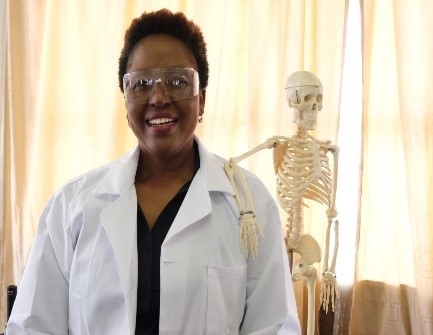
The Dean, ready for action and welcomed by skeleton man into the science discipline./p>
The lab coat fascinated many learners, one of them quipped I would like to be dressed in a wit jas and be a scientist As the Faculty of Education Science Team, we touched the minds of the little ones and got them interested in science. Thato (on the right) copied the Dean, he put on a lab coat and tested Brownian motion with potassium permanganate.
Intermediate Phase (IP) Natural Science (Grade 4-6) and Life sciences (Grade 10 -12): Dr Ayanda Simayi and IP team
One of the aims of the NSW is to contribute to the goals of the Science Engagement Strategy by making science popular to the broader South African society and make STEM appealing to learners, such that they consider science as a preferable career option. The IP team focussed on these aims by constructing models from materials that are readily available in learners’ homes and link these models to science concepts and processes.

In the picture, IP Team preparing models of the Corona virus, bacteria and animal cells with play dough, liquid hand paint and matchsticks. Balloons, straws and empty 1.5l plastic bottles were used to construct the breathing mechanism in the Faculty Science laboratory.
In addition to our models, Mrs Helena Oosthuizen contributed to the Life Sciences exhibition with a model of a skeleton.
In the picture, from left Dr Ayanda Simayi, two First Year PINT102 students Lorcia Newfeldt, Owethu Mayekiso and Nondumiso Ntshangase, the lab technician.
We had microscopes where most learners viewed prepared slides for the first time. A model of the human torso, the heart, the skeleton, chemicals, and electrical connections were in display. It was surprising that all Grade 12 learners asked about gaseous exchange between alveolar membrane and the functioning of the heart. Dr Simayi explained in detail how systemic and pulmonary circulation works and the exchange of gaseous between alveolar membrane and capillary membrane. The excitement of the learners when they looked through the microscope was humbling. They viewed prepared slides of a striated muscle which they correctly indicated as a picture of meat. That was awesome. Most of the learners shared that they were using the microscope for the first time and unfortunately some could not use it due to loadshedding.
Reflections by Nondumiso Ntshangase (Laboratory Technician)
The collaboration between the students and lecturers was a beautiful one as it did not only provide a learning opportunity for our students, but it also opened their eyes up to the possibilities and the different paths they could take in science even outside of the classroom. Our faculty showed massive support, from making all arrangements at such short notice, building our moral leading up to the event and capturing every moment of the preparation. It was an eye-opening occasion to experience working with a diverse group. We built including a breathing model using a 1.5l plastic bottle, balloons and straws. The model showed what happens during inhalation and exhalation.
Reflections by Owethu Mayekiso (IP First year PINT102 student)
I was so privileged that I was one of the selected students to represent Nelson Mandela University at Graaf Reinet for the National Science Week. We had to build models to present at the expo, it was a pretty much awesome experience and I learnt a lot during the process. My main role at the expo was to explain the structure, movement and functioning of the Corona virus using the model. Dr Simayi summarized each presentation by giving a deeper science explanation especially for Grade 11s and 12s. I also explained the basics of a series electric circuit connection and gave learners opportunities to touch the parts and see what happens to the light bulb when more cells were added. Having to interact with the Dean daily was an amazing experience. We were treated like Kings and Queens, accommodation at the lodge and our dinner with the Dean was superb. It was a great way to start my learning to teach journey.
Reflections by Lorcia Newfeldt (IP First year PINT102 student)
Taking part in the National Science gave me the assurance that I was on the right career pathway. Building the models using simple parts like play dough, matchstick and liquid paint was educational and very interesting. My duty was to explain the structure, movement and functions of bacteria using the model. I also explained the functioning of the electric circuit and helped Afrikaans learners who visited our table. Graaf Reinet is mainly an Afrikaans-speaking community so my presence with Dr Simayi’s translation, made learning simpler for the learners. I am grateful the opportunity given to me to be part of the NSW and I enjoyed everything without paying anything, interacted with learners of different grades and with the Dean as well.
Senior Secondary Education SP Natural Science (Grade 7-9): Reflections by Mrs Jennifer Pienaar and SP Team
The Senior Phase (SP) Team introduced learners to activities that represented the CAPS curriculum strand Planet Earth and Beyond (PEB). We wanted to make teachers and students aware that PEB is hands-on and you can make it real. We prepared five hands-on stations based on Grade 7-9 PEB topics; Moon Phases Model, Why We Have Seasons, How Craters Are Formed, The Life Cycle of a Star, and The Solar System. In the picture, from left are Mrs Jennifer Pienaar, two SP students Zenzo Nkosi and Tokoloho Lengoaea.
Robotics in Science
One of our goals was to show students and teachers that basic robotics can easily be incorporated in a NS lesson. Using a simple robot like a BEEBOT, we took a content-heavy Grade 9 topic, the life cycle of a star, and demonstrated how sequencing the life cycle in the correct order can be done through coding the BEEBOT to move across the mat in the correct order.

Planning

Sequencing and Programming

Hands-on collaboration
What do Scientists look like?
At the end of each session, I would ask the group what they think scientists look like. The majority of the students think that scientists wear lab coats, glasses, and work in a lab, study a lot and are “nerdy”. They would also describe a scientist as a man with a beard. I then held up a mirror and told them that they are scientists. Whenever they wonder about the world around them and then start investigating it, they are doing science. The images of science that these students hold showed that they believe science can only be done in a lab, not realizing that, for example, an astronomer studies space or a geologist studies rocks and this can be done in the field without a school science lab.
Good models can be made from everyday materials – by Tokoloho Lengoaea
To stand in front of a group of learners and have them listen to you teach is a great first-time experience for a first-year Natural Sciences Education student. I would often wonder how my former teachers or current lecturers feel when they teach and I learned that it is not always so easy because each learner has his/her own way of absorbing information. Some learners are visual while others are auditory, some are kinesthetic while others learn by reading. The teacher must accommodate them all.
We often think that the materials needed for models are very expensive and that we need fancy laboratories to do science, however I learned that the opposite is true. Good models can be made from everyday materials we have at home. At NSW I noticed that learners learn a lot when they touch objects, participate, and see what the teacher is talking about. From the feedback I received from students at my station, the method of teaching that involves models and hands-on activities worked best when learning about Why We Have Seasons because the students had fun. We used our bodies to illustrate the tilt of the earth and a chair as the sun. I noticed that students were more interested in this topic when they were able to be active participants. What I learned from NSW is that a good teacher is interested in what he/she does and encourages students to ask questions.
Learning through a Hands-on Activity and Playful Learning – by Zenzo Nkosi
What I learnt from this experience is that science does not have to be complicated. You can easily use everyday materials to engage learners in a hands-on experience. My station focussed on Moon Phases which is a topic taught in Grade 7 Natural Sciences but I noticed that Grade 8 and 9 students did not have knowledge of this topic. We used a soccer ball to represent the earth, a tennis ball to represent the moon and a torch to represent the sun in order to simulate how the moon rotates around the earth and changes phases. What I enjoyed most was having learners arrive at my station, not knowing or understanding much about moon phases, and through a hands-on activity and playful learning they gained knowledge.
I would take what I learnt back to any type of school by using everyday materials to develop models for specific topics I am teaching so that learners can visualise what is being taught. I believe each school should have their own science week where they set aside a day to showcase what science really is by using everyday materials and real-life examples.
Clean Energy and Critical Thinking Skills
In the picture, Dr Ron Beyers is engaging students in a “clean energy” demonstration. Students had to apply critical thinking skills to make the blades of the wind turbine turn. Students were also fascinated by the robotic arm that was on display, leading to students becoming more curious about robotics and inquisitive about programming.
Senior Secondary Education FET Physical Science (Grade 10-12): Reflections by Mr William Zivanayi and FET Team
The FET Team was focussed on making STEM interesting to learners, and that objective was achieved with a display of science models that targeted Physical Science in Grade 10 to 12. The National Science Week provided an opportunity to demonstrate some of the experiments which most learners do theoretically in their schools due to the lack of science equipment in schools. One of the basic rules in the laboratory is that the teacher should demonstrate investigations which involve fire and volatile chemicals. This precaution is maintained to protect learners from the danger of being burnt.
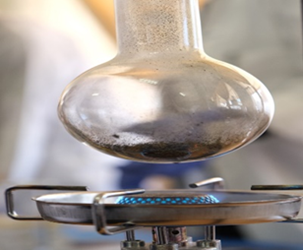
In the picture, heating of chemicals was done under the watchful of Mr Zivanayi.
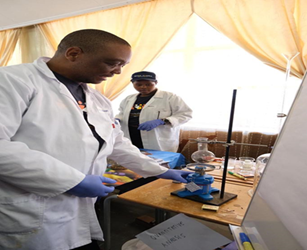
In the picture, Mr Zivanayi explaining the concept of activation energy with Nasiphi watching closely.
We showcased our science innovations in the teaching and learning of science using basic materials. The members of the SSE FET Science Team were Daluxolo Khoza and Nasiphi Humility Mdabula. The display shows heat energy from the Bunsen burner absorbed by the chemicals in the flask. When adequate heat energy had been absorbed (activation energy), the chemicals started to react and produced their own energy to make the reaction continuous. The determination of Boyle’s Law, the demonstration of activation energy (Bomb experiment) and an acid –base titration procedure were presented.
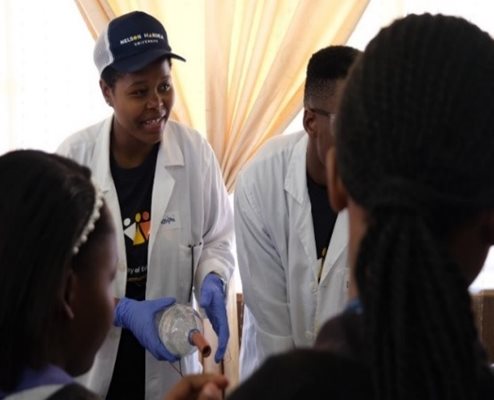
One of the highlights of the exhibitions was the demonstration of the motor effect which was done by FET science students Daluxolo and Nasiphi, using recycled materials as well showcasing the application of the motor effect in our daily lives. The two students designed a vacuum cleaner using simple inexpensive materials such as a two litre (2l) plastic bottle and a small motor to demonstrate the application of the motor effect knowledge taught in schools.
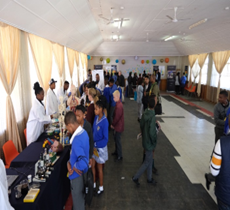
In the picture, FET students Nasiphi Humility Mdabula to the left and Daluxolo Khoza on the right (partially covered by the learner’s head) explaining how to construct a vacuum cleaner from an empty 2 litre cooldrink container, with a motor and cells to a group of Grade 11 learners.
Conclusion
The Faculty of Education captured the theme of the NSW and filled up one side of the hall. Our display captured the excitement of the learners as they moved from one table to the other. We worked as a team, led by the head of the delegation Dr Muki Moeng and we achieved the goals of the NSW by celebrating the role of basic sciences in the modern world with the learners in a dorpie van Graaf Reinet.
